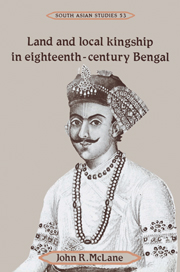Book contents
- Frontmatter
- Contents
- List of tables
- Preface and acknowledgments
- List of abbreviations
- Select glossary
- Map of southwest Bengal
- Part I Bengal
- Part II Burdwan
- 6 Mughal Burdwan and the rise of the Burdwan raj
- 7 Burdwan's expansion
- 8 The Maratha invasions, 1742-1751
- 9 Zamindars and the transition to Company rule
- 10 The famine of 1770
- 11 Revenue farming, 1771-1777
- 12 Zamindari family politics: the Burdwan raj, 1770-1775
- 13 The politics of Burdwan family debt and marriages, 1775-1778
- 14 Testing the limits, 1778–1790
- 15 Burdwan under the Decennial and Permanent Settlements
- 16 Patnis and the elusive quest for independence and security
- 17 Conclusion
- Bibliography
- Index
- Cambridge South Asian Studies
9 - Zamindars and the transition to Company rule
from Part II - Burdwan
Published online by Cambridge University Press: 13 October 2009
- Frontmatter
- Contents
- List of tables
- Preface and acknowledgments
- List of abbreviations
- Select glossary
- Map of southwest Bengal
- Part I Bengal
- Part II Burdwan
- 6 Mughal Burdwan and the rise of the Burdwan raj
- 7 Burdwan's expansion
- 8 The Maratha invasions, 1742-1751
- 9 Zamindars and the transition to Company rule
- 10 The famine of 1770
- 11 Revenue farming, 1771-1777
- 12 Zamindari family politics: the Burdwan raj, 1770-1775
- 13 The politics of Burdwan family debt and marriages, 1775-1778
- 14 Testing the limits, 1778–1790
- 15 Burdwan under the Decennial and Permanent Settlements
- 16 Patnis and the elusive quest for independence and security
- 17 Conclusion
- Bibliography
- Index
- Cambridge South Asian Studies
Summary
C. A. Bayly has argued that “British conquest often meant no more than the slow drift to the East India Company of soldiers, merchants and administrators, leaving the Indian rulers with nothing more than a husk of royal grandeur.” In Bengal after Alivardi's death in 1756, the drift was relatively rapid and massive even though tinged with ambivalent feelings. Certain bankers, merchants, soldiers, and administrators led the way, and the zamindars, with no real options available, fell in line after several years of hesitation and flirtation with resistance.
A deceptive calm had returned to Bengal during the five years between the final Maratha invasion in 1751 and Alivardi's death. In the year of the last Maratha incursion, after almost a decade of major arrears, Alivardi had felt confident enough of his hold on Bengal to add abwabs of Rs. 22.2 lakhs to Bengal's annual revenue demand, bringing the total to Rs. 186.4 lakhs. This was the first in a series of revenue increases that came in rapid succession in the 1750s and 1760s. His diwan, Raja Kiratchandra, had succeeded in collecting a huge sum from Burdwan on account of unpaid balances. The Burdwan raja was Tilakchandra who at the age of fifteen had succeeded his uncle Raja Chitrasen upon his death in 1744. Burdwan raj affairs were dominated in Tilakchandra's youth by its diwan, Raja Manikchandra, who seems to have had closer relations with Alivardi's court than any other zamindari officer in Bengal, perhaps because of partial success in discharging arrears that had accumulated during the Maratha invasions.
- Type
- Chapter
- Information
- Land and Local Kingship in Eighteenth-Century Bengal , pp. 172 - 193Publisher: Cambridge University PressPrint publication year: 1993



